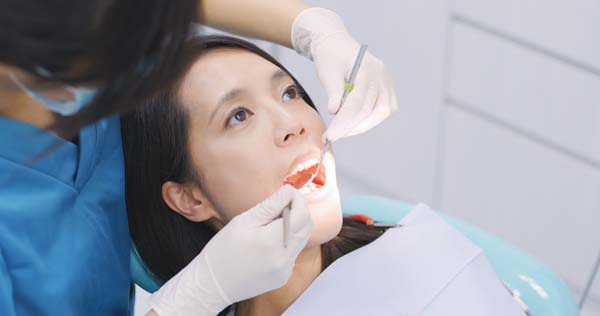What Happens at an Oral Exam at Your Dentist Office?

Has it been some time since you visited the dentist’s office for an oral exam? If so, you may be wondering what the process entails. The following will help you prepare for your visit and alleviate any anxiety you may be feeling.
The oral exam process
While all dentists differ in some ways, most will follow the same steps during an oral exam. This helps to identify any concerns and ensure the health of your teeth. Here is what happens during an oral exam with your dentist.
Medical history
Before the exam, you will be asked for a complete dental and medical history. All medications need to be disclosed as well as any chronic diseases that could affect oral health. This information will allow the dentist to focus on the areas that the chronic condition can affect. It will enable the dental team to create a better oral health care plan for you. If you are visiting a dentist you have already been to, you will likely be asked if the information you provided at the last visit is still correct or if anything has changed.
Initial exam
The dentist, or sometimes a dental hygienist, will do a brief exam to identify any problems before continuing. This is an opportunity for you to point out any pain or issues before heading into the cleaning.
X-rays
X-rays will be taken of the teeth to identify any issues and to create a baseline for future treatments. The dentist can refer to these X-rays when examining changes in the teeth and gums at following visits. X-rays help identify bone loss, abnormalities, tooth decay, gum disease, tumors and cysts.
Cleaning
If there are no immediate problems that would hinder a cleaning, the dentist or a dental hygienist will clean the teeth, gum and mouth. This prepares it for the oral exam by removing anything that can harm the teeth or obstruct the dentist’s view.
Plaque and tartar are scraped from the teeth and gum line with a scaler. Once the plaque and tartar are removed, the hygienist will polish the teeth. A gritty toothpaste and electric toothbrush are used to leave the teeth shiny and smooth. The next step is flossing followed by a fluoride treatment. The fluoride treatment is typically applied as a gel and rinsed out with water.
Final inspection
Finally, the dentist will examine the teeth for gum disease, problems with alignment, signs of grinding or other potential issues. During the final oral exam, dental work such as bridges and fillings are inspected. The dentist will check areas of the mouth and throat for signs of oral cancer.
Continue to maintain your healthy smile by following the dentist’s instructions. Brush and floss daily and avoid foods and drinks that will stain your teeth.
Are you ready for your oral exam?
It is normal to experience anxiety and discomfort when visiting the dentist for the first time or after a long gap in care. Do not let this fear stop you from taking proper care of your health. You now know what to expect and can mentally prepare yourself for the visit.
To schedule your oral exam, call our office to choose a suitable time. We are happy to explain our process to help reduce your concerns.
Are you considering an oral exam in the Columbia area? Get more information at https://columbiadentaloffice.com.
Check out what others are saying about our services on Yelp: Read our Yelp reviews.
Related Posts
A root canal restores a damaged or infected tooth without removing it, and recovery usually proceeds smoothly with the right care. Mild tenderness is common as the tissues calm down, especially when chewing or when the tooth is touched. Good oral hygiene, smart food choices, and timely follow-up help the tooth feel normal again. Because…
Whether you are about to book an appointment for tooth implants or you have just undergone the procedure, you probably want to learn proper aftercare to ensure healing and recovery. One of the questions that patients often ask is what and what not to eat after surgery. Although placing implants ensures that you have dental…
An implant dentist uses artificial tooth roots to anchor a restoration for a lost tooth or teeth. By replacing the lost tooth roots, dental implants provide you the strength and stability needed to chew food and perform other oral functions. Also, they help to stimulate and preserve jawbone structure, stopping bone loss, and maintaining facial…
Choosing between dental bonding and porcelain veneers becomes easier when a cosmetic dentist outlines the benefits, limitations, and long-term value of each option. Many adults today seek smile enhancements that are both natural-looking and durable, but understanding which treatment best fits specific goals can feel overwhelming without professional input. A cosmetic dentist considers factors such…
